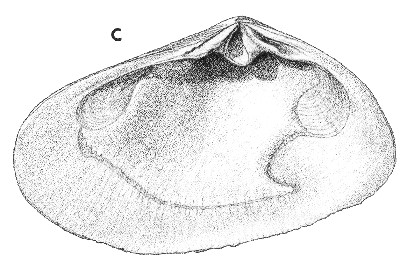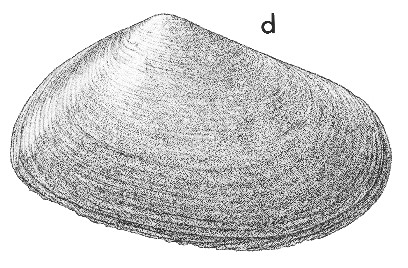
Revised descriptions of New Zealand Cenozoic Mollusca from Beu and Maxwell (1990)

 | Revised descriptions of New Zealand Cenozoic Mollusca from Beu and Maxwell (1990) | 
|
  (Pl. 40c): holotype, Titirangi Sand, Titirangi, Chatham Island, Nukumaruan (TM4738, GNS) |
  (Pl. 40d): holotype, Titirangi Sand, Titirangi, Chatham Island, Nukumaruan (TM4738, GNS) |
Beu & Maxwell (1990): Chapter 15; p. 312; pl. 40 c,d.
Synonymy: Amphidesma (Taria) porrectum Marwick 1928, p. 468
Classification: Mesodesmatidae
Description: Large for genus (83-93 mm long), moderately thick, relatively low, with long rounded anterior end but moderately short, only weakly convex posterior end and lightly angled postero-ventral extremity. Weak ridge extending from umbo to postero-ventral extremity; postero-dorsal area protruding and lightly convex. Exterior sculpture of low growth ridges only. Hinge thick but narrow, with deep, long, vertical, narrowly spoon-shaped resilifer beneath umbo, 1 long, thin, anterior cardinal tooth in each valve, fused with anterior lateral tooth in right valve but separated from it by deep groove in left valve (all other cardinal teeth broken off all material examined); 1 relatively short, thin, anterior and posterior lateral tooth in each valve. Adductor scars subequal, weakly impressed. Pallial line only weakly sinuous, apart from a moderately deep, upward-directed sinus with rounded corners, in front of posterior adductor scar.
Comparison: A similar form to Paphies porrecta still lives today on the sand beaches of Petre Bay, Chatham Island, but Smith et al. (1989) demonstrated that this is a form of P. subtriangulata. Specimens collected from Titirangi Sand at newly discovered localities (north end of Red Bluff, north of Waitangi; Lake Te Wapu, Kaingaroa) also are more similar in shape to P. subtriangulata than to the type material of P. porrecta. Therefore, it seems likely that P. porrecta is merely a synonym of P. subtriangulata, but there is no way to demonstrate this with any certainty. Closely similar forms are also abundant in Tangoio Limestone (Nukumaruan) near Napier, Hawke's Bay. P. donacina, the abundant "southern tuatua" living now on sandy beaches throughout most of New Zealand, and occurring fossil in Mangapanian(?) to Castlecliffian sandy beach facies, differs from P. porrecta and P. subtriangulata in its shorter and more strongly triangular shape, thicker shell, and wider hinge. P. porrecta is also similar in many characters to the "toheroa", Paphies ventricosa (Castlecliffian-Recent), but is much smaller and with less nearly parallel dorsal and ventral margins than P. ventricosa.
Distribution: Nukumaruan; Titirangi Sand, Titirangi Point, Karewa Peninsula, Chatham Island, Nukumaruan (type), abundant; also abundant in Titirangi Sand in the quarry at Moutapu Point, Chatham Island.
Cite this publication as: "A.G. Beu and J.I. Raine (2009). Revised
descriptions of New Zealand Cenozoic Mollusca from Beu and Maxwell (1990). GNS
Science miscellaneous series no. 27."
© GNS Science, 2009
ISBN
978-0-478-19705-1
ISSN 1177-2441
(Included with a PDF facsimile file
copy of New Zealand Geological Survey Paleontological Bulletin 58 in CD version
from: Publications Officer, GNS Science, P.O. Box 30368 Lower Hutt, New
Zealand)